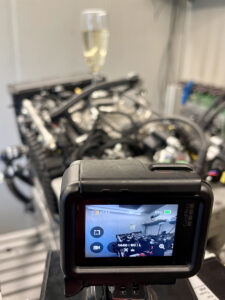The Champagne Engine, or Zero Vibration Generator (ZVG), is a compact two-stroke engine used solely for power generation. It feeds an electric motor via a compact buffer battery, separating it from the vehicle’s drivetrain. The engine, weighing 110kg and producing 45kW, operates in the optimal rev range without the need for variable valve timing.
The engine features two crankshafts operating in opposite directions to eliminate vibrations, a rubber-damped gearbox to minimize noise and an integrated flywheel to balance rotating parts. Encased in a soundproof box, the engine has been designed to be virtually noiseless.
HyperHybrid concept
 The HyperHybrid concept integrates the Champagne Engine and a buffer battery to provide a blend of electric mobility and conventional refueling. This setup is designed to address range anxiety commonly associated with electric vehicles. The vehicle runs on conventional fuel (petrol or e-fuels) and achieves low fuel consumption of around 1.5 liters per 100km, providing a range of over 1,000km without the need for recharging.
The HyperHybrid concept integrates the Champagne Engine and a buffer battery to provide a blend of electric mobility and conventional refueling. This setup is designed to address range anxiety commonly associated with electric vehicles. The vehicle runs on conventional fuel (petrol or e-fuels) and achieves low fuel consumption of around 1.5 liters per 100km, providing a range of over 1,000km without the need for recharging.
The buffer battery, weighing 98kg, consists of stacked cylindrical cells insulated to maintain favorable temperature conditions. With 17.3kWh capacity, it has a purely electric range of over 80km, sufficient for most daily trips.
The Obrist Group claims the HyperHybrid concept is ready for production and presents an alternative to purely battery-electric vehicles.
While the Champagne Engine emits CO2 when running on gasoline, the company says its emissions are minimal due to low fuel consumption. If powered by sustainably produced e-fuels, the Champagne Engine could achieve a “CO2-negative” balance, as the production of synthetic fuel can sequester more CO2 than the engine emits during operation, according to Obrist.
The HyperHybrid concept could have strong prospects in Europe, especially if the proposed 2035 ban on internal combustion vehicles includes exemptions for cars using e-fuels.

 The HyperHybrid concept integrates the Champagne Engine and a buffer battery to provide a blend of electric mobility and conventional refueling. This setup is designed to address range anxiety commonly associated with electric vehicles. The vehicle runs on conventional fuel (petrol or e-fuels) and achieves low fuel consumption of around 1.5 liters per 100km, providing a range of over 1,000km without the need for recharging.
The HyperHybrid concept integrates the Champagne Engine and a buffer battery to provide a blend of electric mobility and conventional refueling. This setup is designed to address range anxiety commonly associated with electric vehicles. The vehicle runs on conventional fuel (petrol or e-fuels) and achieves low fuel consumption of around 1.5 liters per 100km, providing a range of over 1,000km without the need for recharging.